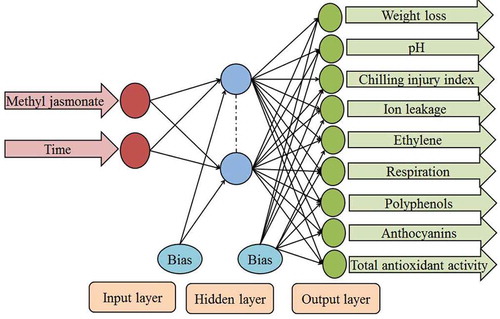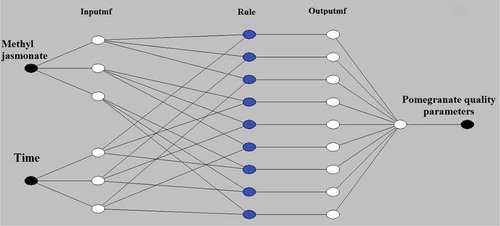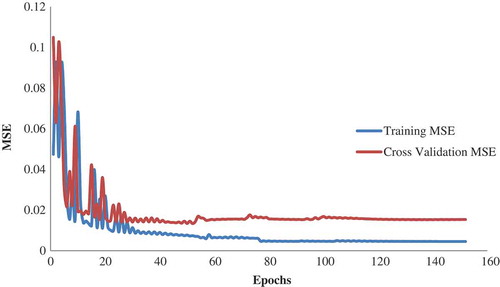ABSTRACT
Adaptive neuro fuzzy inference system (ANFIS) and genetic algorithm–artificial neural network (GA-ANN) models were used to predict the effect of methyl jasmonate (at three levels 0, 0.01, and 0.1 mM) and storage time (0, 14, 28, 42, 56, 70, and 84 days) on quality parameters and physiological changes of pomegranate fruits during storage. Methyl jasmonate reduced chilling injury and improved quality characteristics of pomegranates during postharvest storage. The GA-ANN and ANFIS were fed with two inputs of methyl jasmonate and storage time. The results showed that GA-ANN predictions agreed with experimental data and the GA-ANN with 14 neurons in one hidden layer can predict physiological changes and quality parameters of pomegranate (weight loss, pH, chilling injury index, ion leakage, ethylene, respiration, polyphenols, anthocyanins, and total antioxidant activity) with correlation coefficients equal to 0.87. The ANFIS model was trained by a hybrid method and agreement between experimental data and ANFIS predictions was significant (r = 0.90).
Introduction
Methyl jasmonate is a volatile organic compound used in plant defense and many diverse developmental pathways, such as seed germination, root growth, flowering, fruit ripening, and reducing chilling injury. Plants produce methyl jasmonate in response to many biotic and abiotic stresses, which build up in the damaged parts of the plant (Cheong and Do Choi, Citation2003).
The effect of postharvest application of methyl jasmonate on reactive oxygen species, antioxidant systems, and cellular structure in Chinese winter jujube at the major ripening stages of green maturity and half-red maturity were investigated by Dong et al. (Citation2016). The methyl jasmonate can be used to signal the original plant’s defense systems or it can be spread by physical contact or through the air to produce a defensive reaction in unharmed plants (Cheong and Do Choi, Citation2003). Recent research has shown that methyl jasmonate treatment reduced the development of chilling injury symptoms in fruits, including mango (Gonzalez-Aguilar et al., Citation2000), guava (Gonzalez-Aguilar et al., Citation2004), tomato (Ding et al., Citation2001), loquat (Cao et al., Citation2010), and pomegranate (Sayyari et al., Citation2011). Effects of hot air and methyl jasmonate treatment on the metabolism of soluble sugars in peach fruit during cold storage was studied by Yu et al. (Citation2016). The results show that the increase in sucrose during cold storage, associated with high sucrose phosphate synthase and lower acid invertase levels, enhances the chilling tolerance observed in hot air and methyl jasmonate-treated fruit.
Pomegranate is a typical fruit from many subtropical and tropical countries. This fruit is highly valued mainly due to its exceptional and unique sensory and nutritional properties. Their high anthocyanin content is appreciated due to its strong chemopreventive activities (López-Rubira et al., Citation2005). Pomegranate arils contain a high concentration of organic acids, sugars, polysaccharides, vitamins, essential minerals, polyphenol, and has antioxidant properties (Al-Maiman and Ahmad, Citation2002). Refrigeration is necessary to prolong the storability of pomegranate, but the fruits are subject to chilling injury and the severity increased with low temperatures (from 3 to 5 °C) and long duration. Chilling injury in this fruit includes scald and husk browning, pitting, and softness (Mirdehghan et al., Citation2007). To extend storability and reducing chilling injury of pomegranate, good results were obtained with treatments with salicylic acid and methyl jasmonate prior to cold storage. Pomegranates were treated with acetyl salicylic acid after harvest and then stored under chilling temperature by Sayyari et al. (Citation2011). The control fruit exhibited more chilling injury symptoms than treated fruit during storage, accompanied by increased softening, ion leakage, and respiration rate.
The physiological change of fruits following postharvest treatments is a highly nonlinear one involving respiration and quality loss. Adaptive neuro-fuzzy inference system (ANFIS) and artificial neural networks (ANN) are an analytical alternative to conventional modeling techniques, which are frequently limited by strict assumptions of normality, linearity, homogeneity, and variable independence (Salehi, Citation2014). Fuzzy inference systems and ANN are model-free numerical estimators. To use the effectiveness of both, fuzzy inference systems and ANN could be combined into an integrated system called ANFIS (Ramzi et al., Citation2015; Salehi and Razavi, Citation2016).
The most popular ANN is the multi-layer feed-forward neural network, where the neurons are arranged into layers of input, hidden, and output. Feed-forward neural network usually has one or more hidden layers, which enable the network to model nonlinear and complex functions. In this type of ANNs, information flows in the forward direction only. The number of input neurons corresponds to the number of input variables into the neural network, and the number of output neurons is similar to the number of desired output variables. In between the input and the output layers, there is at least one hidden layer that can have any number of neurons. The number of neurons in the hidden layers depends on the application of the network. In the hidden and output layers, the net input (xj) to node j is of the form (Ramzi et al., Citation2015; Salehi and Razavi, Citation2016):
where yi are the inputs, Wij are the weights associated with each input/node connection, n is the number of nodes, and bj is the bias associated with node j. Additionally, bias is an extra input added to neurons. Each neuron consists of a transfer function expressing internal activation level. Output from a neuron is determined by transforming its input using a suitable transfer function. The transfer function can be linear or nonlinear (commonly sigmoid and hyperbolic tangent) functions depending on the network topology (Ramzi et al., Citation2015; Salehi and Razavi, Citation2016).
Fuzzy logic is an important decision making tool that has recently found some applications in food quality control. The ANFIS model has the unique benefit that no clear relationship between the input and output variables needs to exist before the model is applied, since the relationship is identified through a self-learning process. The ANFIS is a feed-forward neural network of six layers. ANFIS has the excellent ability of approximation and generalization. Sugeno fuzzy model is the popular fuzzy model applied in ANFIS. ANFIS with zero-order Sugeno model has been proved to have universal approximation ability under certain circumstances (Bahram-Parvar et al., Citation2016).
Neural networks and neuro-fuzzy models were used for potato storage process modeling (Abdulquadri Oluwo et al., Citation2013), detecting chilling injury in ‘Red Delicious’ apple (Elmasry et al., Citation2009), to detect defects (leaf roller, bitter pit, russet, puncture, and bruises) in ‘Empire’ and ‘Golden Delicious’ apples (Kavdır and Guyer, Citation2004), and improved the climate control for stored potato (Gottschalk et al., Citation2003). Controlling drying of olive stones (Javadikia et al., Citation2011), controlling in a microwave-based Chinese herbs drying equipment (Lu et al., Citation2006), grain drying (Mansor et al., Citation2010), and developing a dynamic model for the rotary drying plant (Areed et al., Citation2012).
ANN and ANFIS models do not require the prior knowledge of the relationship between the input and output variables because they can discover the relationship through successive training. Moreover, these models can predict several output variables at the same time, which is difficult in general regression methods. The aim of this study was investigation of ANFIS and GA-ANN models performance to modeling methyl jasmonate effects on pomegranates quality parameters, including weight loss, pH, chilling injury index, ion leakage, ethylene, respiration, polyphenols, anthocyanins, and total antioxidant activity, during storage under chilling conditions.
Materials and methods
Pomegranate preparation and storage
Pomegranates (Punicagranatum L. cv. Mollar de Elche) fruits after harvesting at fully mature stage based on the skin color changes are immediately transported to the laboratory. This is a late-ripening cultivar with delicious sweet arils and soft stones. Fruits (about 600) were harvested when fully mature according to commercial practice based on the skin color changes to brownish-yellow with reddish patches. Initially, 225 pomegranates were randomized and divided into three lots for the following treatments: control, methyl jasmonate at 0.1 and 0.01 mM concentration (Sigma, Spain). Treatments were performed at 20 °C for 16 h. The samples were stored in at 2 °C with relative humidity of 90%. Every 2 weeks one batch was transferred to a chamber for analytical determinations (20 °C for 4 days). The arils of each replicate, obtained from equatorial fruit zones, were combined and frozen in liquid N2, milled and stored at –20 °C for determinations of total antioxidant activity, total anthocyanins, and total phenolics (Sayyari et al., Citation2011). Pomegranates quality parameters, including weight loss, pH, chilling injury index, ion leakage, ethylene, respiration, polyphenols, anthocyanins and total antioxidant activity (TAA), were evaluated in each fruit according to our previous reports (Sayyari et al., Citation2011).
Phenolic extraction for each sub-sample was performed using water-methanol (2:8) containing 2 mM NaF (to inactivate polyphenols oxidase activity and prevent phenolic degradation) and quantified using the Folin–Ciocalteu reagent and results were expressed as mg pyrogallol equivalent 100 g–1 FW, both purchased from Sigma-Aldrich (Madrid, Spain). A relative calibration procedure was performed using pyrogallol at 5–20 µg in the reaction medium, which showed linearity with the absorbance at 760 nm (y = 0.035× + 0.0078; R2 = 0.995).
Total anthocyanins were determined according to previous reports (Sayyari et al., Citation2011) and calculated as cyanidin 3-glucoside equivalent (molar absorption coefficient of 23,900 l cm–1 mol–1 and molecular weight of 449.2 g mol–1) and results expressed as mg 100 g–1 FW, and were the mean ± SE.
Total antioxidant activity was quantified according to Arnao et al. (Citation2001), which enables the determination of TAA due to both hydrophilic and lipophilic compounds in the same extraction. Briefly, for each sub-sample, 5 g of tissue were homogenized in 5 ml of 50-mM phosphate buffer (pH = 7.8) and 3 ml of ethyl acetate, and then centrifuged at 10,000g for 15 min at 4 °C. The upper fraction was used for total antioxidant activity due to lipophilic compounds (L-TAA) and the lower for total antioxidant activity due to hydrophilic compounds (H-TAA). In both cases, TAA was determined using the enzymatic system composed of the chromophore 2,2ʹ-azino-bis-(3-ethylbenzothiazoline-6-sulfonic acid) diammonium salt (ABTS), the horse radish peroxidase enzyme and its oxidant substrate (hydrogen peroxide), in which ABTS+ radicals are generated and monitored at 730 nm.
GA-ANN model
shows the artificial neural network construction applied in this study. The number of input neurons network corresponds to the number of input variables (methyl jasmonate concentration and storage time), and the number of output neurons is the number of target output variables (quality parameters of pomegranate; Bahramparvar et al., Citation2014; Ramzi et al., Citation2015; Salehi and Razavi, Citation2016). A genetic algorithm optimization technique was used for determination of optimum number of neurons in a hidden layer. A sigmoid activation function was used as the transfer function in the hidden and output layers (Eq. 2):
In this study, all data (3 Replication × 7 Times × 3 Methyl jasmonate concentration = 63 data series) were randomly divided into three partitions: training (60%), validating (10%), and testing data (30%). The probabilities of the mutation operators and crossover were adjusted at 0.01 and 0.9, respectively (Salehi and Razavi, Citation2012). The Neurosolution software 6.01 (NeuroDimension, Inc., Gainesville, FL, USA) was used for GA-ANN modeling of data.
ANFIS model
A hybrid training method was used as the training method of the ANFIS (Salehi and Razavi, Citation2016). The data order was first randomized and then all data were separated into three partitions. Further, 60%, 10%, and 30% of data were used for training, validating, and testing the network, respectively. Each input/output pair contained two inputs (methyl jasmonate concentration and storage time) and one output (quality parameters of pomegranate; ). The number of membership functions (MFs) assigned to each input variable is chosen by trial and error. The ANFIS toolbox of Matlab 7.6 (Mathworks, Natick, MA, USA) was used to obtain the results, and to build an ANFIS model for predicting the quality parameters of pomegranate.
Statistical analysis
Data for the analytical determinations were subjected to analysis of variance (ANOVA). Sources of variation were storage time and treatment. All analyses were performed with SPSS software (SPSS Inc., Chicago, IL, USA).
Results and discussion
Pomegranate quality
Treated fruits with methyl jasmonate had lower chilling injury index than control fruits during the storage period (). A summary of the statistical results is shown in . Results would suggest that methyl jasmonate has potential postharvest applications in reducing chilling injury, maintaining quality, and improving the health benefits of pomegranate fruit consumption by increasing the antioxidant capacity. Chilling injury limits the distribution and storage of pomegranate and causes extensive postharvest losses. Methyl jasmonate generally led to significant increases in total phenolics, total anthocyanins, and total antioxidant activity. The content of total phenolics in the arils increased from the initial levels of 233 ± 8 to 284 ± 3 mg 100 g–1 at the end of the experiment in control fruits. The total phenolic was slightly higher for 0.1 than 0.01 mM concentration, with significant differences in the last three sampling dates. Total anthocyanins also increased with storage period in both control and treated fruits, although for this case, the increase induced by treatments was observed from the first sampling date and was generally maintained over the storage period, without significant differences among treatments and applied doses. Total antioxidant activity was determined separately in hydrophilic and lipophilic fractions. Hydrophilic antioxidant activity was significantly higher than lipophilic with values at harvest of 82 ± 6 and 16 ± 1 mg 100 g–1, respectively, and for both parameters a net decrease (≈ 25%) was obtained until the end of the storage period in control arils.
Table 1. Effects of methyl jasmonate on pomegranate quality during postharvest storage.
Table 2. ANOVA for dependent variables for methyl jasmonate treatments, storage time, and their interactions for pomegranate.
There is increasing evidence that fruit consumption imparts beneficial health effects based on the content of several phytochemical compounds with antioxidant activity, including ascorbic acid, flavonoids, and phenolic compounds such as anthocyanins (Valero and Serrano, Citation2010).
GA-ANN results
ANN techniques are currently being used in many food process modeling applications. In this study, a GA-ANN model was developed for estimation the effects of methyl jasmonate on pomegranate quality. First, the GA-ANN networks were trained by 38 data points. The training process was carried out for 1000 epochs or until the cross-validation data’s mean-squared error (MSE) did not improve for 100 epochs to avoid over-fitting of the network. A plot of the MSE and the number of epochs is shown in . A sharp drop was observed for MSE in the first little iteration (fast training) and training was completed after about 120 epochs. This is a well-known characteristic of the Levenberg–Marquardt (LM) optimization method (Salehi and Razavi, Citation2012). illustrates the weight and bias values of the optimum GA-ANN, which could be used to predict the effects of methyl jasmonate on pomegranate quality. The results showed that the GA-ANN with 14 hidden neurons had the minimum mean absolute error values and high correlation coefficients for quality parameters of pomegranate prediction, respectively (). The overall agreement between GA-ANN predictions and experimental data was also significant (r = 0.87). For example, the calculated correlation coefficient value for estimation of total antioxidant activity shows a high correlation between predicted and experimental values (). These results show the potential of the proposed techniques for predicting total antioxidant activity.
Table 3. The weights and bias values of optimized GA-ANN model for prediction methyl jasmonate effects on pomegranate fruit quality.
Table 4. Performance of optimized GA-ANN (2/14/9) for prediction methyl jasmonate effects on pomegranate fruit quality.
Figure 4. Experimental vs. predicted values of total antioxidant activity using GA-ANN model for test data (r = 0.89).
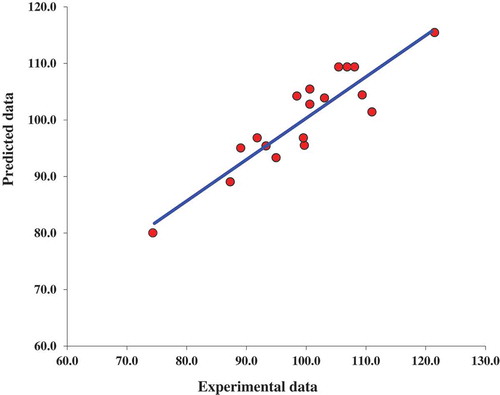
ANN and hyperspectral techniques were used to model quality changes in avocados during storage at different temperatures (Maftoonazad et al., Citation2011). Multilayer ANNs were used in two ways to develop models for predicting quality parameters during storage. The optimal configuration of a neural network model was obtained by varying the different model parameters. Results indicated ANN models to be accurate and versatile and they predicted the quality changes in avocado fruits better than the conventional regression models; furthermore, the storage time–temperature-based ANN models were better than the hyperspectra-based ANN models.
Feed-forward back-propagation ANN models were developed by Elmasry et al. (Citation2009) to investigate the ability of hyperspectral imaging and ANN techniques for the detection of chilling injury in ‘Red Delicious’ apples. They reported that classification accuracy of above 90% was obtained with the use of five selected optimal wavelengths. In another study, neural network models were used to predict shelf life of greenhouse lettuce by Lin and Block (Citation2009). Using two-stage neural network models, an R2 of 0.61 could be achieved for predicting remaining shelf life. This study indicated that neural network modeling has the potential for cold chain quality control and shelf life prediction.
ANFIS results
The ANFIS network parameters, such as the type and number of MF, have been varied to obtain the best results in terms of model validation. ANFIS architecture used in this study is shown in . The final ANFIS architecture for predicting quality parameters of pomegranate, with three Gaussian-type MFs for each input (methyl jasmonate and storage time) and linear MF for output, and construction of nine rules resulted in a highly accurate prediction. A plot of the training error and the number of epochs is shown in . ANFIS training was completed after about 80 epochs (very fast training). The performance of optimized ANFIS for prediction methyl jasmonate effects on pomegranate fruit quality was reported in . It can be seen that the ANFIS model was well trained to modeling methyl jasmonate effects on pomegranate quality during postharvest storage (r = 0.90).
Table 5. Performance of optimized ANFIS for prediction methyl jasmonate effects on pomegranate fruit quality.
Figure 5. Adaptive neuro fuzzy inference system training error as a function of the number of iterations.
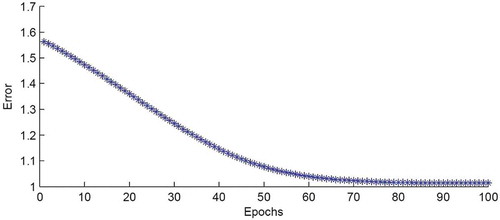
In , the total antioxidant activity values versus ANFIS predictions for test data are shown. It can be seen that the system was well trained to model the weight loss (r = 0.92).
Figure 6. Experimental vs. predicted values of total antioxidant activity using ANFIS model for test data (r = 0.92).
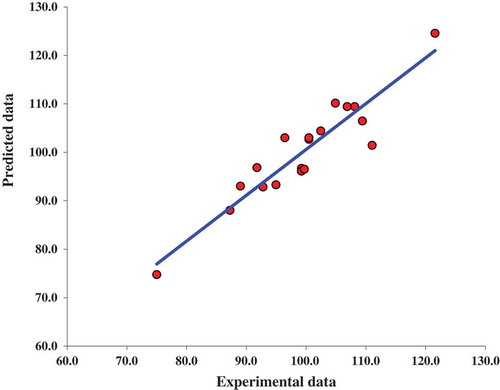
May et al. (Citation2011) and Wali et al. (Citation2013) used fuzzy logic to reduce the operational times and cooling energy generation of the chilling system. The fuzzy logic controller tracked the reactor desired temperature precisely with minimal overshoot and a fast warm-up phase. A disturbance in the form of varying flow rate in the process input was well rejected by the controller.
Conclusion
Treatment of pomegranate fruits with methyl jasmonate reduced chilling injury index and increased bioactive compounds and antioxidant activity. The application of GA-ANN and ANFIS to modeling of methyl jasmonate effects of pomegranate fruit’s quality characteristics (weight loss, pH, chilling injury index, ion leakage, ethylene, respiration, polyphenols, anthocyanins, and total antioxidant activity) during storage was studied. It was found that GA-ANN with one hidden layer comprising 14 neurons in the hidden layer gives the best fitting with the experimental data, which made it possible to predict quality parameters of pomegranates with satisfactory correlation coefficient (0.87). It was also found that ANFIS model with three Gaussian-type MFs for input variables (methyl jasmonate and time) and linear for output gives the best fitting with the experimental data that predict quality parameters with a correlation coefficient equal to 0.92. However, the ANFIS model performs better than the GA-ANN model and this method can be applied to relevant postharvest storage projects with satisfactory results.
Literature cited
- Abdulquadri Oluwo, A., M. Khan, and M.J.E. Salami. 2013. Optimized neural network model for a potato storage system. ARPN J. Eng. Appl. Sci. 8:449–454.
- Al-Maiman, S.A., and D. Ahmad. 2002. Changes in physical and chemical properties during pomegranate (Punica granatum L.) fruit maturation. Food Chem. 76:437–441.
- Areed, F.F.G., M.S. El-Kasassy, and K.A. Mahmoud. 2012. Design of neuro-fuzzy controller for a rotary dryer. Intl. J. Comput. Appl. 37:34–41.
- Arnao, M.B., A. Cano, and M. Acosta. 2001. The hydrophilic and lipophilic contribution to total antioxidant activity. Food Chem. 73:239–244.
- Bahram-Parvar, M., F. Salehi, and S.M.A. Razavi. 2016. Adaptive neuro-fuzzy inference system (ANFIS) simulation for predicting overall acceptability of ice cream. Eng. Agr. Environ. Food. doi:10.1016/j.eaef.2016.11.001
- Bahramparvar, M., F. Salehi, and S. Razavi. 2014. Predicting total acceptance of ice cream using artificial neural network. J. Food Process. Preserv. 38:1080–1088.
- Cao, S., Y. Zheng, K. Wang, H. Rui, and S. Tang. 2010. Effect of methyl jasmonate on cell wall modification of loquat fruit in relation to chilling injury after harvest. Food Chem. 118:641–647.
- Cheong, J.-J., and Y. Do Choi. 2003. Methyl jasmonate as a vital substance in plants. Trends Genet. 19:409–413.
- Ding, C.-K., C.Y. Wang, K.C. Gross, and D.L. Smith. 2001. Reduction of chilling injury and transcript accumulation of heat shock proteins in tomato fruit by methyl jasmonate and methyl salicylate. Plant Sci. 161:1153–1159.
- Dong, Y., H.H. Zhi, J. Xu, L.H. Zhang, M.P. Liu, and W. Zong. 2016. Effect of methyl jasmonate on reactive oxygen species, antioxidant systems, and microstructure of Chinese winter jujube at two major ripening stages during shelf life. J. Hort. Sci. Biotechnol. 91:316–323.
- ElMasry, G., N. Wang, and C. Vigneault. 2009. Detecting chilling injury in Red Delicious apple using hyperspectral imaging and neural networks. Postharvest Biol. Technol. 52:1–8.
- Gonzalez-Aguilar, G., J. Fortiz, R. Cruz, R. Baez, and C. Wang. 2000. Methyl jasmonate reduces chilling injury and maintains postharvest quality of mango fruit. J. Agr. Food Chem. 48:515–519.
- Gonzalez-Aguilar, G., M. Tiznado-Hernandez, R. Zavaleta-Gatica, and M. Martınez-Téllez. 2004. Methyl jasmonate treatments reduce chilling injury and activate the defense response of guava fruits. Biochem. Biophys. Res. Commun. 313:694–701.
- Gottschalk, K., L. Nagy, and I. Farkas. 2003. Improved climate control for potato stores by fuzzy controllers. Comput. Electron. Agr. 40:127–140.
- Javadikia, P., M.H. Dehrouyeh, L. Naderloo, H. Rabbani, and A.N. Lorestani. 2011. Measuring the weight of egg with image processing and ANFIS model, p. 407–416. In: B. K. Panigrahi, P. N. Suganthan, S. Das, and S. C. Satapathy (eds.). Swarm, Evolutionary, and Memetic Computing. Springer, Berlin, Heidelberg.
- Kavdır, I., and D. Guyer. 2004. Comparison of artificial neural networks and statistical classifiers in apple sorting using textural features. Biosys. Eng. 89:331–344.
- Lin, W.-C., and G.S. Block. 2009. Neural network modeling to predict shelf life of greenhouse lettuce. Algorithms 2:623–637.
- López-Rubira, V., A. Conesa, A. Allende, and F. Artés. 2005. Shelf life and overall quality of minimally processed pomegranate arils modified atmosphere packaged and treated with UV-C. Postharvest Biol. Technol. 37:174–185.
- Lu, C., Z. Liao, H. Jia, and G. Chai. 2006. Design of fuzzy control system of the fast drying equipment for Chinese herbs. Intl. J. Info. Technol. 12:65–72.
- Maftoonazad, N., Y. Karimi, H.S. Ramaswamy, and S.O. Prasher. 2011. Artificial neural network modeling of hyperspectral radiometric data for quality changes associated with avocados during storage. J. Food Process. Preserv. 35:432–446.
- Mansor, H., M. Noor, S. Bahari, R. Ahmad, R. Kamil, F.S. Taip, and O.F. Lutfy. 2010. Intelligent control of grain drying process using fuzzy logic controller. J. Food Agr. Environ. 8:145–149.
- May, Z., N.M. Nor, and K. Jusoff. 2011. Optimal operation of chiller system using fuzzy control. In: Proceedings of the 10th WSEAS International Conference on Artificial Intelligence, Knowledge Engineering and Data Bases (pp. 109–115). World Scientific and Engineering Academy and Society (WSEAS).
- Mirdehghan, S., M. Rahemi, S. Castillo, D. Martínez-Romero, M. Serrano, and D. Valero. 2007. Pre-storage application of polyamines by pressure or immersion improves shelf-life of pomegranate stored at chilling temperature by increasing endogenous polyamine levels. Postharvest Biol. Technol. 44:26–33.
- Ramzi, M., M. Kashaninejad, F. Salehi, A.R. Sadeghi Mahoonak, and S.M. Ali Razavi. 2015. Modeling of rheological behavior of honey using genetic algorithm–artificial neural network and adaptive neuro-fuzzy inference system. Food Biosci. 9:60–67.
- Salehi, F. 2014. Current and future applications for nanofiltration technology in the food processing. Food Bioprod. Process. 92:161–177.
- Salehi, F., and S.M.A. Razavi. 2012. Dynamic modeling of flux and total hydraulic resistance in nanofiltration treatment of regeneration waste brine using artificial neural networks. Desalination and Water Treatment 41:95–104.
- Salehi, F. and S.M.A. Razavi. 2016. Modeling of waste brine nanofiltration process using artificial neural network and adaptive neuro-fuzzy inference system. Desalin. Water Treat. 57:1–10.
- Sayyari, M., S. Castillo, D. Valero, H.M. Díaz-Mula, and M. Serrano. 2011. Acetyl salicylic acid alleviates chilling injury and maintains nutritive and bioactive compounds and antioxidant activity during postharvest storage of pomegranates. Postharvest Biol. Technol. 60:136–142.
- Valero, D., and M. Serrano. 2010. Postharvest biology and technology for preserving fruit quality. CRC Press, London, UK.
- Wali, W., J. Cullen, S. Bennett, and A. Al-Shamma’a. 2013. Intelligent PID controller for real time automation of microwave biodiesel reactor. Intl. J. Comput. Info. Technol. 2:809–814.
- Yu, L., H. Liu, X. Shao, F. Yu, Y. Wei, Z. Ni, F. Xu, and H. Wang. 2016. Effects of hot air and methyl jasmonate treatment on the metabolism of soluble sugars in peach fruit during cold storage. Postharvest Biol. Technol. 113:8–16.

